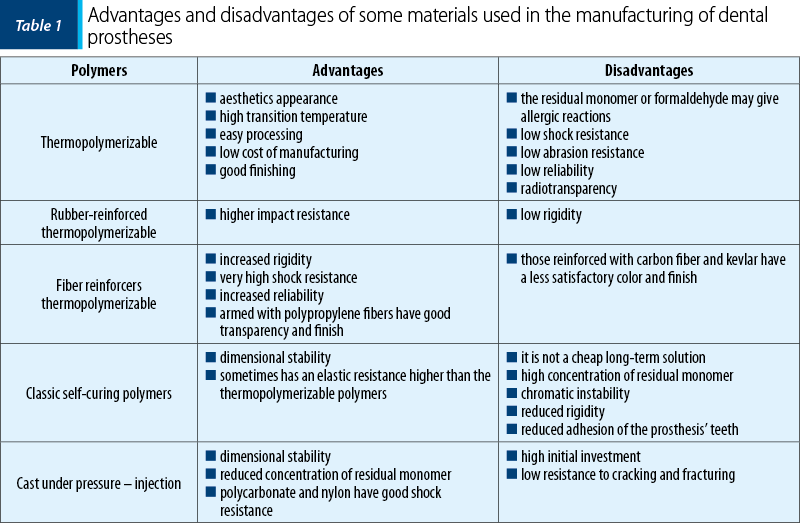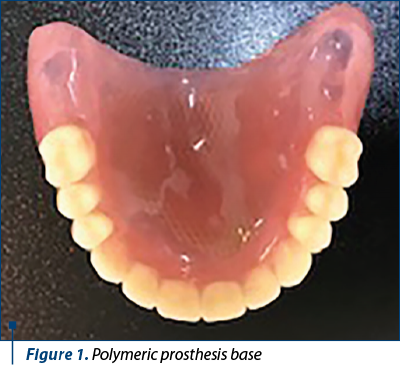The polymeric materials for the dental prosthesis were imposed in the Romanian dentistry due to the good physical-chemical and biological properties, easy processing, low cost, but also due to the aesthetic aspects, so desired by the patient. Materials and method. A total of 162 cases from the authors’ clinical practice were analyzed. The patients received cosmetic restorations through dental prostheses, with different prosthetic materials. We made a comparison of the effects of the long-term benefits of using these materials in relation to biological aesthetics and their costs. Results and conclusions. After the different treatment options used in the study group, the metal-polymeric prosthesis occupied the second place (33.33%) regarding the choice of dental material, related to properties, aesthetics or durability, the choice being dictated by the socioeconomic criteria of patients.
Aspecte fizico-chimice ale materialelor polimerice în terapia estetică prin proteze dentare
Physical and chemical aspects of polymeric materials in cosmetic dental prosthetic therapy
First published: 04 noiembrie 2020
Editorial Group: MEDICHUB MEDIA
DOI: 10.26416/ORL.48.3.2020.3756
Abstract
Rezumat
Materialele polimerice pentru proteza dentară au fost impuse în stomatologia românească datorită proprietăţilor fizico-chimice şi biologice bune, prelucrării uşoare, costurilor scăzute, dar şi datorită aspectelor estetice, dorite de pacient. Materiale şi metodă. Au fost analizate 162 din cazurile practicii clinice ale autorilor. Pacienţii au primit restaurări cosmetice prin proteze dentare, cu diferite materiale protetice. S-a făcut o comparaţie între efectele beneficiilor pe termen lung ale utilizării acestor materiale în raport cu estetica biologică şi costurile acestora. Rezultate şi concluzii. După diferitele opţiuni de tratament utilizate în grupul de studiu, proteza metalo-polimerică ocupă locul al doilea (33,33%) în ceea ce priveşte alegerea materialului dentar, legat de proprietăţile acestora (estetică, durabilitate), alegerea fiind dictată de criteriile socioeconomice ale pacienţilor.
Introduction
From 1939 until now, the mobile prostheses technology has been dominated by polymethacrylate methyl (PMMA), which has been imposed due to its good physical, chemical and biological properties, as well as its easy handling and processing, allowing the development of multiple technological processes: pressing, injection, casting etc.
The currently domination of PMMA is assigned to a combination of favorable properties(1-5):
-
very good physical and chemical behavior;
-
simple handling and processing;
-
the possibility of being reoptimized;
-
very good chromatic stability;
-
achieving an optimal connection with artificial teeth made of plastic material;
-
transparency, with very good aesthetic effect;
-
good biocompatibility.
According to these qualities, PMMA could be designated as the ideal material for making dental prostheses. However, this polymer has also multiple disadvantages, therefore, over time, other materials have been tried for making mobile prostheses. In this regard, the research focused on finding and developing other polymers, with superior properties. Two ways were followed: on the one hand, new types of RA were developed, with superior properties, due to the methacryloyloxy group, CH₂=C(CH₃)COO- (from methyl methacrylate), and on the other hand, other polymers have been developed and patented: diacrylic, epoxy, polycarbonate, epimine resins etc.(6-16)
The ideal properties of a non-metallic polymer material, used for dental prostheses or their components, are the following:
-
to have the color and nature of the tissue that it replaces and possess a translucency or transparency that allows its aesthetic reproduction;
-
it does not change its color or shade in the technological process of making the prosthesis, nor in the oral environment;
-
it does not change its dimensions and it does not deform during processing or in the oral environment, respectively to have dimensional stability in all conditions;
-
to have an elasticity and wear resistance appropriate to any requests present in the oral cavity;
-
to be impermeable to fluids in the oral environment, thus preventing the appearance of an unpleasant smell and changes in the taste perception;
-
to enable optimal surface polishing, non-sticky to foods or other materials introduced into the oral cavity, such as plaque, and allowing an optimum cleaning;
-
to make a preferable chemical connection with other polymers or with heterogeneous materials used to manufacture different components of certain prostheses;
-
the temperature of the plasticizer should be much higher than the temperature of the oral environment and of all the foods or liquids introduced into the mouth.
At present, the properties of polymers used in making the bases of complete or partial prostheses are improved in at least three directions(6-16):
-
ensuring the radio-opacity of the material;
-
increasing the impact resistance;
-
increased rigidity.
Among the polymers with chemical initiating process prevails the MMA/PMMA system, introduced in dentistry in 1936, by the process of compaction and pressing and curing in a humid environment(6-16).
In fact, it is plastics with inorganic and organic filling, fiber reinforced (for example, microbases)(19,20).
For photopolymeration it is used as the initiator of camphorquinone, and the microwave polymerization (diacrylic composite) is initiated by a peroxide with high decomposition temperature(17,18).
Diacrylic composite resins (DRC) have superior properties to acrylic, such as, for example, low polymerization shrinkage, higher values of physical-mechanical strength, chemical and electrical resistance, physical and chemical characteristics, superior thermal insulation etc. These qualities have made the DRC prostheses that replace acrylic resins mobile technology for certain uses: artificial teeth (with a much higher mechanical strength to the acrylic).
Table 1 presents comparatively the advantages and disadvantages of some materials used in the manufacturing of dental prostheses(6-16).

Materials and method
A total of 162 cases were analyzed, from the last five years of the authors’ clinical practice. The patients received cosmetic restorations through dentures, with different dental materials. We made a comparison of the effects of long-term benefits of using these materials in relation to biological aesthetics and their costs.
Treatment
Figure 1 shows a polymeric prosthesis base used for the treatment of the patients in the study group, in the author’s private practice.
Results and discussion
Table 2 shows the treatment variants adopted in the aesthetic restorations, in case of the study group.
Patients seeking cosmetic treatment are the most significant ones. There were proposed several treatment options to restore the aesthetic appearance of the teeth. For many years, the predictable and lasting aesthetics correction of the teeth was obtained with total crown preparations. However, this is an invasive therapy because it involves the removal of a significant amount of dental substance and the adverse effects may occur in the pulp or periodontal tissues. Regarding the prevalence of therapeutic approaches in the study group, the composite solutions win, with a percentage of 35.19%, followed by acrylic metal restoration material (33.33%), and composite metal crowns (16.67%). The lower percentage of therapeutic approaches regards ceramic and metal-ceramic, with 9.26% and 3.70%. The choice in these cases was dictated by the socioeconomic criteria of the patients. After the different treatment variants used in the study group, the metal-acrylic prosthesis occupied the second place (33.33%) regarding the choice of dental material, related to properties, aesthetics, durability, the choice being dictated by the socioeconomic criteria of the patients.
Conclusions
Currently, society places great emphasis on the aesthetics of the face which is particularly important for the development of normal relationships in a society. The aesthetic appearance of the face is largely determined by the visible dental arches during speech and the relationship between teeth and smile with the facial structures.
Acknowledgments: All authors have the same contribution with the first author.
For any experiments on humans, all work was conducted in accordance with the Declaration of Helsinki (1964). Papers describing experimental work which carries a risk of harm to human subjects include a statement that the experiment was conducted with the human subjects’ understanding and consent.
Bibliografie
-
Jagger DC, Harrison A, Jandt KD. The reinforcement of dentures. Int J Prosthod. 2000; 13, 526-530.
-
Jagger DC, Harrison A, Jandt KD. The reinforcement of dentures. J Oral Rehab. 1999; 26(3): 185-188.
-
Janda R. Prothesenkunststoffe aus werkstoffkundlicher Sicht. Quintessenz Zahntech. 1997; 23(5):665-672.
-
Jemt T. Failures and complications in 391 consecutivley inserted fixed prostheses suported by Bränemark implants in edentulos jaws: a study of treatment from the time of prostheses placement to the first annual ceckup. Int J Oral Maxillofac Implants. 1991; 6(3):270-276.
-
Jemt T, Carlsson L, Boss A, Jorneus L. In vivo load measurements on osseointegrated implants supporting fixed or removable prostheses: a comparative pilot study. Int J Oral Maxillofac Implants. 1991; 6(4):413-417.
-
Bratu D, Colojoară C, Leretter M, Ciosescu D, Uram-Ţuculescu S, Romînu M. Materialele utilizate în laboratorul de tehnică dentară, curs de materiale dentare, vol III. Ed. Lito UMF Timişoara, 1994, p. 55-75.
-
Bratu D, Colojoară C, Leretter M, Ciosescu D, Uram-Ţuculescu S, Romînu M. Materialele dentare în laboratorul de tehnică dentară, vol. 3. Ed. Helicon, Timişoara, 1994; p. 60-72.
-
Gavrilă-Ardelean L, Bratu D. Protezarea edentaţiei totale. Ed. Waldpress, Timişoara; 2012, p. 25-35.
-
Rogers OW. Electroformed metal palates for complete dentures. J Prosthet Dent. 1970; 23(2):207-217.
-
Ernst M DZW. Galvano kommt von Galvani. Die Galmnotechnik - Geschichte. Anwrendungen und Spezialitäten. Zahn Technik (München). 2002; 10, 18-20.
-
Weigl P, Lauer HC. Advanced biomaterials used for a new telescopic retainer for removable dentures. J Biomed Mater Res. 2000; 53(4):337-347.
-
Diedrichs G. Galvanoforming-Bioästhetik für festsitzende Restaurationen. Quintessenz Zahntech (München). 1996; 22(5):551- 562.
-
Diedrichs G, Rosenhain P. Galvano-Aufenteleskope in der direkten. Technik Quintesenz. 1991; 42, 49.
-
Raupach M, Unkelbach ADZW. Galvono-Keramikverblend-brücke eignet sich besonders für Allergiepatienten. Zahn Technik Heft. 2002; 5(18):19-22.
-
Khurshid Z, Najeeb S, Zafar SM, Sefat F. Advanced Dental Biomaterials. WoodHead Publishing, Elsevier. 2019; p. 22-26.
-
Göbel R, Welker D, Hilpert M, Küpper H. Verbundfesligkeil mit Galvanogold bei Verblendung und Befesligung. Dtsch Zahnarztl Zeitschrift. 2002; 57(10):594-598.
-
Welker D, Lenz E. Prothesenkunststoffe – Chemie, Technologie und klinische Bewährung. Quintessenz Zahntech. 1997; 23(5):649-660.
-
Williamson DL, Boyer DB. Aquilino SA, Leary JM. Effect of polyethylene fiber reinforcement on the strength of denture base resins polymerized by microwave energy. J Prosthet Dent. 1994 Dec; 72(6):635-638.
-
Kalbfleisch H. Microbase – das innovative Prothesenherstellungsverfahren. Quintessenz Zahntech. 1997; 23(4):525-530.
-
Kalipçilar B, Karaagaçlioglu L, Hasanreisoglu U. Evaluation of the level of residual monomer in acrylic denture base materials having different polymerization properties. J Oral Rehabil. 1991 Sep; 18(5):399-401.
Articole din ediţiile anterioare
Restaurările estetice adezive directe în zona laterală
Acest articol prezintă caracteristicile restaurărilor estetice realizate cu materiale aderente la nivelul dinţilor laterali. Sunt prezentate ma...

